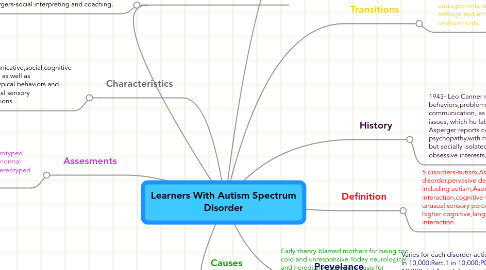Learners With Autism Spectrum Disorder
저자: Stacee Weber

1. Causes
1.1. Early theory blamed mothers for being too cold and unresponsive.Today neurological and hereditary causes are basis for autism.
2. Assesments
2.1. No universal diagnostic tests for ASD.Criteria is based on communication skills,social interaction and repetetive,sterotyped behavior for autism, for Aspergers it is based on close to normal comunication skills but social interaction problems and stereotyped behaviors,to a lesser extent.
3. Characteristics
3.1. Communicative,social,cognitive deficits, as well as stereotypical behaviors and abnormal sensory perceptions.
4. Educational Considerations
4.1. Autistic-communication skill, ASD-direct instruction in natural settings,behavior management using functional behavior assesment and positive behavior supports,Aspergers-social interpreting and coaching.
5. History
5.1. 1943- Leo Canner reported behaviors,problems with change and communication, as well as social interaction issues, which he labelled "autistic".1944- Hans Asperger reports cases of autistic psychopathy,with normal intelligence,language but socially isolated and extraordinarily narrow obsessive interests.
6. Definition
6.1. 5 disorders-autism,Asperger's Syndrome,Rett Syndrome,Childhood Disintegration disorder,pervasive developmental disorder not.Autism Spectrum Disorders are a subset, including autism,Aspergers.PDD.Severe Deficits in communication, social interaction,cognitive functioning,repetetive,stereotyped behavior,resistance to change and unusual sensory perceptions are characteristics of autism.Aspergers is characterized by higher cognitive,language skills than autism but with problems in other areas,social interaction.
7. Prevelance
7.1. Varies for each disorder-autism,20 in 10,000;Aspergers,5 in 10,000;Rett,1 in 10,000;PDD-NOS,15 in 10,000;childhood disintigrative disorder,0.2 in 10,000.Numbers have risen dramatically.
8. Interventions
8.1. Family involvement,intensive and highly structured usingnatural environments.
9. Transitions
9.1. autism-person centered planning, involving living arrangements in residential facilities,supported living settings and employment in competetive or supportive environments.


